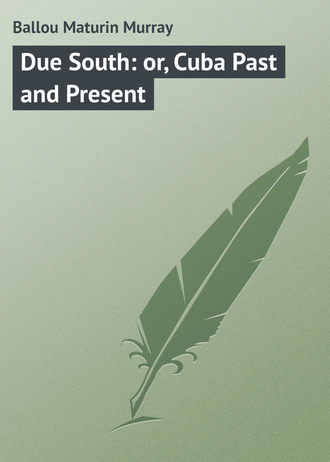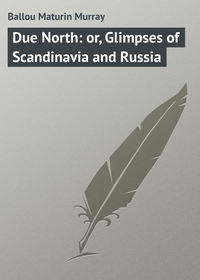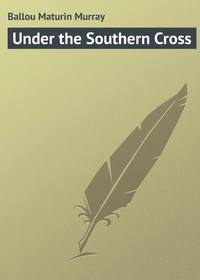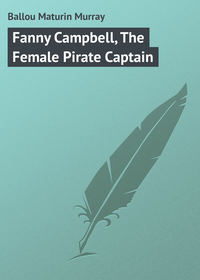 полная версия
полная версияDue South: or, Cuba Past and Present
The sea was like molten sapphire as we glided swiftly along the southern coast of Cuba, watching the gracefully undulating shore. The mountains rose higher and higher, until they culminated in the lofty peak of Pico Turquino (blue mountain), over ten thousand feet high, as lately ascertained by actual measurement. There are coves and bays along this coast where oysters do grow upon trees, ridiculous as the assertion first strikes the ear. The mangrove-trees extend their roots from the shore into the sea, to which the oysters affix themselves, growing and thriving until plucked by the fishermen. They are small and of an inferior species compared with those of our own coast, but are freely eaten in the island. Near the shore hereabouts are many islets containing from three to five square miles, some of which are quite barren, while others are delicious gardens, full of tropical fruit trees, flowers, and odoriferous plants, where Paul and Virginia might have felt quite at home, wandering hand in hand.
Soon after passing the remarkably sheltered port of Guantanamo, which was for nearly a century the most notorious piratical rendezvous in the West Indies, the famous castle of Santiago is seen. It is known as Moro Castle, but it antedates the more familiar Moro of Havana by a full century. This antique, yellow, Moorish-looking stronghold – which modern gunnery would destroy in about eight minutes – is picturesque to the last degree, with its crumbling, honeycombed battlements, and queer little flanking turrets, grated windows, and shadowy towers. It is built upon the face of a lofty dun-colored rock, upon whose precipitous side the fortification is terraced. It stands just at the entrance of the narrow channel leading to the city, so that in passing in one can easily exchange oral greetings with the sentry on the outer battlement. What strikingly artistic pictures the light and shade together formed with those time-stained walls, as we steamed slowly by them! On the ocean side, directly under the castle, the sea has worn a gaping cave, so deep that it has not been explored within the memory of the people living in the neighborhood. The broad and lofty entrance is in form as perfect an arch as could be drawn by the pencil of a skillful architect. As is usual with such formations all over the world, there is a romantic legend concerning the cave related as connected with the olden time, and there is also a prevailing superstition, that no one attempting to explore it will live to return.
In passing up the channel two or three little forts of queer construction are seen, supplementing the larger one, placed upon jutting headlands. The Moro of Santiago is now used as a prison for political offenders; its days of defensive importance ended with the period of the buccaneers, against whose crude means of warfare it was an ample protection. As we steamed past it that sunny afternoon, stimulated by the novelty of everything about us, a crowd of pallid, sorrowful faces appeared at the grated windows, watching us listlessly. Two days later five of them, who were condemned patriots, were led out upon those ramparts and shot, their bodies falling into the sea, and eight were sent to the penal settlement of Ceuta. Spain extends no mercy to those who dare to raise their hands or voices in favor of freedom; her political existence is sustained only in an atmosphere of oppression and cruelty. Every page of her history is a tableau of bloodshed and torture. The narrow winding channel which leads from the open sea to the harbor passes through low hills and broad meadows covered with rank verdure, cocoanut groves, and little fishing hamlets. Thrifty laurels, palms with their graceful plumes of foliage, and intensely green bananas line the way, with here and there upon the banks a pleasant country house in the midst of a pretty garden of flowering shrubs. So close is the shore all the while that one seems to be navigating upon the land, gliding among trees and over greensward rather than on blue water. Presently we pass a sharp angle of the hills into a broad, sheltered bay, and before us lies the quaint, rambling old city of Santiago de Cuba, built upon a hillside, like Tangier in Africa, and nearly as Oriental as that capital of Morocco. The first most conspicuous objects to meet the eye are the twin towers of the ancient cathedral which have withstood so many earthquakes. The weather-beaten old quartermaster on our forecastle applies the match to his brass twelve-pounder, awaking a whole broadside of echoes among the mountains, the big chain rushes swiftly through the hawse-hole, and the ship swings at her anchor in the middle of the picturesque bay.
A boat was promptly secured with which to land at this ancient city, founded by Velasquez. From the moment one touches the shore a sense of being in a foreign land forces itself upon the new-comer. The half-unintelligible language, the people, the architecture, the manners, the vegetation, even the very atmosphere and the intensity of the sunshine, are novel and attractive. It is easy to convey our partial impressions of a new place, however unique it may be, but not our inward sensations. The former are tangible, as it were, and may be depicted; the latter are like atmospheric air, which cannot be seen, but is felt. The many-colored, one-story houses of Santiago are Moorish in architecture, ranged in narrow streets, which cross each other at right angles with considerable regularity, but with roadways in an almost impassable condition, lined with sidewalks of ten or fifteen inches in width. These thoroughfares were once paved with cobblestones, but are now characterized by dirt and neglect, a stream of offensive water constantly percolating through them, in which little naked children are at play. No wonder that the city is annually decimated by yellow fever; the surprise is that it does not prevail there every month in the year. The boys and girls of the lower classes, white and black, are not thought to require clothing until they are about nine years of age. A few negresses were observed sitting on the ground, at the corners of the streets, beside their baskets containing sweet cakes, mouldy biscuits, bananas, and grape-fruit, the uninviting appearance of which seemed to indicate that they were in the last stage of collapse. Was it possible any one could eat such stuff? As we passed and repassed these patient waiters, certainly no purchasers appeared. How the forty-five thousand inhabitants manage to achieve a living it would be difficult to imagine, for the town seemed to be as dead and void of all activity as Cordova, in far-off Spain, the sleepiest city in all Europe. Santiago has not a single bookstore within its limits. No other place in Christendom, with so numerous a population, could exist, outside of Spain, without some literary resort. There are here three or four spacious two-story club-houses, with some pretension to neatness and social accommodations; but then no Cuban town of any size would be complete without these anti-domestic institutions, where the male population may congregate for evening entertainment. The interior arrangements of these club-houses were entirely exposed to view, as we passed by the iron-grated windows, devoid of curtains, blinds, or screens of any sort, and extending from ceiling to floor.
Santiago dates back to the year of our Lord 1514, making it the oldest city in the New World, next to San Domingo, and it will be remembered as the place whence Cortez sailed, in 1519, to invade Mexico. Here also has been the seat of modern rebellion against the arbitrary and bitterly oppressive rule of the home government. The city is situated six hundred miles southeast of Havana, and, after Matanzas, comes next to it in commercial importance, its exports reaching the handsome annual aggregate of eight millions of dollars. It is the terminus of two lines of railways, which pass through the sugar districts, and afford transportation for this great staple. Three leagues inland, among the mountains, are situated the famous Cobre copper mines, said to be of superior richness, and whence, in the days of their active working, four million dollars' worth of the ore has been exported in one year. This was the amount shipped in 1841, and so late as 1867 six thousand tons were exported in ten months. Not content with realizing a very large income from the mines by way of taxes upon the product, the Spanish government increased these excise charges to such an extent as to absorb the entire profits of the works and kill the enterprise, so that the rich ores of Cobre now rest undisturbed in the earth. It seems there is an Indian village near the copper mines, whose people are represented to be the only living descendants of the aborigines, – the Caribs whom Columbus found here on first landing. Careful inquiry, however, led us seriously to doubt the authenticity of the story. Probably this people are peculiar in their language, and isolation may have caused them to differ in some respects from the inhabitants of the valley and plains, but four centuries must have destroyed every trace of the early inhabitants of Cuba. Having been from the very outset enslaved and brutally treated by the Spaniards, it is believed that as early as the year of our Lord 1700 they had utterly disappeared, and some historians say no trace even was to be found of the native race one century after the settlement of the island by Europeans.
The head of the Church of Rome in Cuba is located here, it being an archbishop's see; and the elaborate ceremonials which occasionally take place attract people from the most distant cities of the island. We chanced to be present when the bishop was passing into the cathedral, clothed in full canonicals and accompanied by church dignitaries bearing a canopy above his head. Observing our little party as strangers, though in the midst of a stately ceremony, the bishop graciously made us a sign of recognition. The cathedral of Santiago is the largest in Cuba, but extremely simple in its interior arrangements; and so, indeed, are all the churches on the island. As to the exterior, the façade resembles the cathedral of Havana, being of the same porous stone, which always presents a crumbled and mottled surface. The inside decorations are childish and fanciful, consisting mostly of artificial flowers of colored paper, crudely formed by inexperienced hands into stars, wreaths, and crosses. One innovation was noticed in this church: a saint on the right of the altar was mounted upon a wooden horse, with spear in rest à la militaire, forming a most incongruous figure. In the church of Matanzas, visited a week or two later, the effigy of our Saviour was observed to be half dressed in female attire, a glaring absurdity which the author has once before seen in the Spanish convent-church of Burgos. In the Matanzas church alluded to, boys and girls of nine and ten years were seen at the confessional. Could absurdity be carried to a greater height? These with negro women form nearly all the audiences to be met with in the Cuban churches, unless upon festal occasions. The men manifest their indifference by their absence, and white women are scarcely represented. Besides the cathedral, Santiago has three or four other old churches, small and dilapidated, within whose sombre walls one seems to have stepped back into the fifteenth century. Upon strolling accidentally into one of these we felt a chill suffuse the whole system, like that realized on descending into a dark, undrained cellar.
The multiplicity and gaudiness of the drinking-saloons and bar-rooms were particularly noticeable in passing along the principal streets, and all were doing a thriving business, judging from appearances. The Cubans drink lightly, but they drink often, and are especially addicted to gin, which is dealt out to them at an extraordinarily low price. It appears that people can consume a much larger quantity of spirituous liquors here without becoming intoxicated than they can do at the North. It is very rare to see a person overcome by this indulgence in Cuba, and yet, as was afterwards observed in Cienfuegos, Matanzas, and Havana, the common people begin the day with a very liberal dram, and follow it up with frequent libations until bed-time, – tippling at every convenient opportunity. A few of the better class of private houses were constructed with courts in the centre, where flowers and tropical fruits were growing luxuriantly. These dwellings were confined to no special quarter of the town, but were as often found next to a commercial warehouse or a negro shanty as elsewhere. The dogs, horses, and Chinese coolies were all in wretched condition. One might count the ribs of the first two a long way off, while the latter were ragged, lame, half-starved, and many of them blind. Animals are the recipients of the severest sort of usage both in Cuba and Spain. Few vehicles were to be seen, as merchandise is mostly transported on the backs of mules and ponies, and these animals are seldom shod.
The town is lighted with gas, or rather it was so illuminated a few weeks since; but it was quietly whispered about that the corporation had failed to pay for this service last year, and that the monopoly itself was on the verge of bankruptcy, like nearly everything else of a business character in Cuba. The gaslights certainly appeared pale and sickly enough, as though only half confirmed in the purpose of giving any light at all, and were prematurely extinguished in many of the streets. In the shops, whose fronts were all open, like those of Canton and Yokohama, the clerks were to be seen in their shirt sleeves, guiltless of vests or collars, coquetting over calicoes and gaudy-colored merinos with mulatto girls decked in cheap jewelry, and with negresses wearing enormous hoop-earrings. At the approach of evening the bar-rooms and saloons, with a liberal display of looking-glasses, bottles of colored liquors, gin, and glitter, were dazzling to behold. The marble tables were crowded with domino and card players, each sipping at intervals his favorite tipple. The sidewalks are so narrow that the pedestrian naturally seeks the middle of the street as a pathway, and the half a dozen victorias and four volantes which form the means of transportation in Santiago, and which are constantly wandering about in search of a job, manage to meet or to overtake one perpetually; causing first a right oblique, then a left oblique, movement, with such regularity as to amount to an endless zig-zag. We did not exactly appreciate the humor of this annoyance, but perhaps the drivers did. After climbing and descending these narrow, dirty streets by daylight and by gaslight, and watching the local characteristics for a few hours, one is only too happy to take a boat back to the ship, and leave all behind.
A desire for a cold bath and a good swim is natural in this climate after sunset, but beware of indulging this inclination in the waters of Santiago. Under that smooth, inviting surface, glistening beneath the rays of a full moon, lurk myriads of sharks. They are large, hungry, man-eating creatures, the tigers of the ocean, and the dread of all local boatmen here. To fall overboard in these waters, however good a swimmer one may be, is simply to be devoured. At Singapore, Sumatra, or Batavia, a Malay will for a consideration dive into the waters of the Malacca Straits, armed with a long, sharp knife, boldly attack a shark, and rip open his bowels at the moment when he turns on his side to give the deadly bite. But on that coast this dreaded fish appears singly; it is rare to see two of them together; while Santiago harbor seems to swarm with them, the dark dorsal fin of the threatening creatures just parting the surface of the sea, and betraying their presence. Lying at anchor between our ship and the shore was a trig Spanish corvette, – an American-built vessel, by the way, though belonging to the navy of Spain. It was curious at times to watch her crew being drilled in various martial manœuvres. While an officer was exercising the men at furling topsails, a few days before our arrival, a foretopman fell from aloft into the sea. Under ordinary circumstances and in most waters, the man could easily have been saved, but not so in this instance. He did not even rise to the surface. A struggle for portions of his body between half a dozen ravenous sharks was observed alongside the corvette, and all was quickly over. The foretopman had been torn limb from limb and instantly devoured.
The over-stimulated brain felt no inclination for sleep on this first night in the harbor, the situation was so novel, and the night itself one to suggest poetic thoughts. The moon was creeping slowly across the blue vault, like a great phantom mingling with the lambent purity of the stars. We sat silently watching the heavens, the water, and the shore; saw the lights go out one after another among the clustering dwellings, and the street gas-burners shut off here and there, until by and by the drowsy town was wrapped in almost perfect darkness. Only the ripple of the sea alongside the ship broke the silence, or the sudden splash of some large fish, leaping out of and falling back into the water. It seemed as though no sky was ever before of such marvelous blue depth, no water so full of mystery, no shore so clad in magic verdure, and no night ever of such resplendent clearness. The landing-steps and grating had been rigged out from a broad porthole on the spar deck, where a quartermaster was awaiting the return of the purser and a party of gentlemen who were making late, or rather early, hours on shore; for it was nearly two o'clock in the morning, and the weary seaman, who had sat down at his post on the grating, was snoring like a wheezy trombone. The measured tread fore and aft of the second officer, who kept the anchor watch, was the only evidence of wakefulness that disturbed our lonely mood. A similar night scene was vividly called to mind as experienced in Typhoon Bay, below Hong Kong, a few years since.
In the harbor, next morning, a sunken wreck was pointed out to us, which was partially visible at low tide, not far from the shore. Only the ribs and stanchions are still held together by the stout keel timbers and lower sheathing. This wreck has lain there unheeded for years, yet what a story these old timbers might tell, had they only a tongue with which to give voice to their experience! – literally the experience of ages. We refer to the remains of the old St. Paul, one of the ships of the great Spanish Armada that Philip II. sent to England in 1588, being one of the very few of that famous flotilla that escaped destruction at the time. What a historical memento is the old wreck! After a checkered career, in which this ancient craft had breasted the waves of innumerable seas and withstood the storms of nearly three centuries, she was burned to the water's edge here in the harbor of Santiago a few years since, and sunk, where her remains now lie, covered with slime and barnacles, – a striking emblem of the nation whose flag she once proudly bore. During the last years of her career afloat she was used for transporting troops from Europe, and as a Spanish guard-ship in these seas by the local government. It is doubtful if it is generally known that this relic of the Spanish Armada is in existence. Curio-hunters, once put upon the scent, will probably soon reduce these ancient timbers to chips, and a crop of canes and snuff-boxes, more or less hideous and more or less counterfeit, will ensue.
Here we got our first experience of the present currency, – the valueless circulating medium of Cuba. When one has occasion to visit the island it is best to take American funds, either in bank-bills or gold, sufficient to meet all ordinary expenses. Our bank-bills and our gold are both at a premium. This will also save all necessity for drawing on home through any local bankers, who have a way of charging for the accommodation quite after the style of everything Spanish. The hotel-keepers will require their pay on the basis of Spanish gold, but will cheerfully allow a premium of six per cent. on American gold or American bank-bills. As to the banks in Cuba, all are shaky, so to speak; several have lately failed, and the others might as well do so. It is not long since the president of the Havana Savings Bank placed a pistol at his temple and blew his brains out. Mercantile credit may be said to be dead, and business nearly at a standstill. Commercial honesty is hardly to be expected from a bankrupt community, where the people seem only to be engaged in the sale and purchase of lottery tickets, a habit participated in by all classes.
What little gold and silver coin there is found in circulation is mutilated; every piece of money, large and small, has been subjected to the ingenious punch, and thus has lost a portion of its intrinsic value. American gold and silver, not having been thus clipped, justly commands a six per cent. premium.
The circulating medium upon the island is paper scrip, precisely similar to that used in this country before the resumption of specie payment. This scrip is dirty beyond endurance, and one absolutely hesitates to take it in making change.
When our currency became soiled and torn we could exchange it for new, but there is no such facility in Cuba. One dollar of our money will purchase $2.45 of this scrip. It passes current, and really seems to answer the necessities of trade, but even the Cubans are not deceived by it. They know that it is really worthless, being based upon nothing, and issued indiscriminately by a bankrupt government. The paper-mill grinds it out in five, ten, twenty, and fifty cent pieces as fast as it can be put into circulation, while no one knows how much has been issued. But one thing is known; namely, that every authorized issue of a given sum has been enormously exceeded in amount.
Within about five years, or less, an issue of bank-bills and of this small currency was entrusted to an establishment in the United States, when fourteen millions of dollars were printed in addition to the amount authorized! All were duly receipted for and signed by corrupt Spanish officials, who coolly divided these millions among themselves! The Captain-General of Cuba during whose administration this financial stroke was accomplished came to the island a poor man, and returned to Spain in two years possessed of three million dollars!
There is no more beautiful or safe harbor in the world than that of Santiago de Cuba, commercially speaking, as it is completely land-locked and protected on all sides from storms; but for the same reason it is as close and hot an anchorage as can be found in the tropics. An intelligent resident gave us 80° Fahrenheit as the average temperature of the year, though the thermometer showed a more ambitious figure during our brief stay. There are but two seasons, the wet and the dry, the latter extending from September to May. The city might have an excellent water supply if there were sufficient enterprise among the citizens to cause it to be conducted by pipes from the springs in the neighboring hills. It is now wretchedly deficient in this respect, causing both suffering and ill health in a climate especially demanding this prime necessity of life.
CHAPTER III
Doubling Cape Cruz. – Trinidad. – Cienfuegos. – The Plaza. – Beggars. – Visit to a Sugar Plantation. – Something about Sugar. – An Original Character. – A Tropical Fruit Garden. – Cuban Hospitality. – The Banana. – Lottery Tickets. – Chinese Coolies. – Blindness in Cuba. – Birds and Poultry. – The Cock-Pit. – Negro Slavery, To-Day. – Spanish Slaveholders. – A Slave Mutiny. – A Pleasant Journey across the Island. – Pictures of the Interior. – Scenery about Matanzas. – The Tropics and the North contrasted.
To reach Cienfuegos, our next objective point, one takes water conveyance, the common roads in this district being, if possible, a degree worse than elsewhere. It is therefore necessary to double Cape Cruz, and perform a coasting voyage along the southern shore of the island of about four hundred miles. This is really delightful sailing in any but the hurricane months; that is, between the middle of August and the middle of October. It would seem that this should be quite a commercial thoroughfare, but it is surprising how seldom a sailing-vessel is seen on the voyage, and it is still more rare to meet a steamship. Our passage along the coast was delightful: the undulating hills, vales, and plains seemed to be quietly gliding past us of their own volition; the tremor of the ship did not suggest motion of the hull, but a sense of delight at the moving panorama so clearly depicted. No extensive range of waters in either hemisphere is so proverbially smooth as the Caribbean Sea, during eight months of the year, but a stout hull and good seamanship are demanded during the remaining four, especially if coming from the northward over the Bahama Banks and through the Windward Passage, as described in these chapters.









